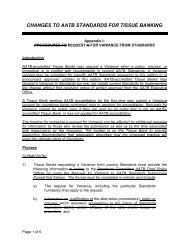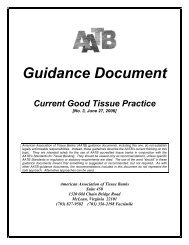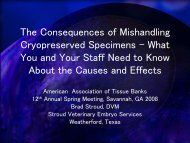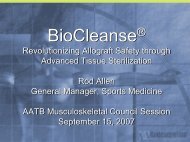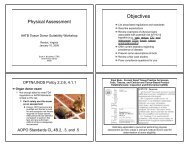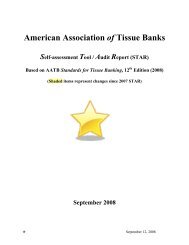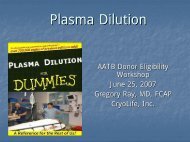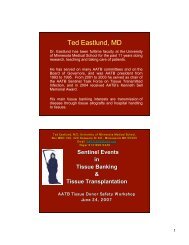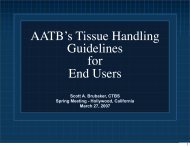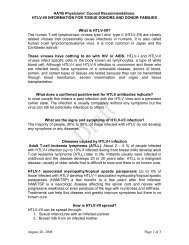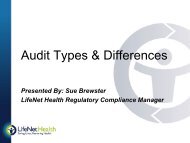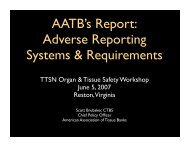3/18/2011 1 navigating the us citizenship art maze - American ...
3/18/2011 1 navigating the us citizenship art maze - American ...
3/18/2011 1 navigating the us citizenship art maze - American ...
You also want an ePaper? Increase the reach of your titles
YUMPU automatically turns print PDFs into web optimized ePapers that Google loves.
3/<strong>18</strong>/<strong>2011</strong><br />
NAVIGATING THE U.S.<br />
CITIZENSHIP ART MAZE<br />
U.S. Citizenship – Land or Blood<br />
<strong>American</strong> Association of Tissue Banks<br />
15 th Annual Spring Meeting<br />
March 28, <strong>2011</strong><br />
A<strong>us</strong>tin, Texas<br />
By Kathleen Campbell Walker<br />
Cox Smith Mat<strong>the</strong>ws Incorporated<br />
kwalker@coxsmith.com<br />
www.coxsmith.com<br />
• J<strong>us</strong> Soli – 14 th Amendment, §301(a) Immigration<br />
and Nationality Act, as amended (“INA”)<br />
• “All persons born or naturalized in <strong>the</strong> United States,<br />
and subject to <strong>the</strong> jurisdiction <strong>the</strong>reof, are citizens of<br />
<strong>the</strong> United States and of <strong>the</strong> State wherein <strong>the</strong>y<br />
reside.”<br />
• [subject to <strong>the</strong> jurisdiction – persons born in <strong>the</strong> U.S.<br />
to foreign born diplomats 8 CFR §101.3(a)(1)]<br />
Birth Abroad – J<strong>us</strong> Sanguinis (Law of <strong>the</strong><br />
Bloodline)<br />
Child’s Claim through linkage to parents by:<br />
• Blood<br />
• Adoption<br />
• Surrogacy<br />
Statute in effect at time of birth critical<br />
Birth Abroad - Acquisition of Citizenship at<br />
Time of Birth<br />
Consular Report of Birth Abroad (“CRBA”) 20 CFR<br />
§ 50.7<br />
Birth Abroad to U.S. Citizen (“USC”) Parents<br />
• One parent has prior residence in U.S. INA §301(c)<br />
Birth Abroad to a USC parent and foreign national<br />
• USC resided in US or outlying possessions for 5<br />
years before child’s birth (2 of 5 after age 14)<br />
(often DNA evidence required)<br />
Surrogacy and <strong>the</strong> U.S. State Dep<strong>art</strong>ment<br />
(“DOS”)<br />
Determination of Citizenship governed by U.S. law<br />
INA §§301 and 309<br />
• Even if local law recognizes surrogacy agreement<br />
and finds U.S. parents are legal parents of child<br />
conceived through ART<br />
• DOS does not pre-adjudicate <strong>citizenship</strong><br />
determinations<br />
• Best evidence with a foreign surrogate is DNA<br />
testing<br />
Surrogacy and DOS<br />
• If child not biologically related to USC parent – child<br />
will not acquire USC at birth<br />
• In some countries – child will not acquire <strong>citizenship</strong><br />
of birth country beca<strong>us</strong>e surrogate mo<strong>the</strong>r is not<br />
parent (i.e. not possible to obtain passport)<br />
1
3/<strong>18</strong>/<strong>2011</strong><br />
Importance of CRBA<br />
Typical ART Evidence for CRBA<br />
• CRBA certifies that child born abroad is USC<br />
• CRBA does not determine legal parents<br />
• Only names on CRBA are generally <strong>the</strong> USC parent<br />
with <strong>the</strong> biological connection to <strong>the</strong> child<br />
• Medical and Documentary Evidence of child’s<br />
Conception and Birth – 7 FAM 1446.2-2<br />
• Evidence of Parent’s Identity, Citizenship, and<br />
Physical Presence in US, as required<br />
• Possible DNA test of Child (note that passports for<br />
minors under 16 normally require <strong>the</strong> approval of<br />
both legal parents of <strong>the</strong> child 22 CFR §51.28)<br />
Out of Wedlock Rules<br />
• If child biologically related to USC fa<strong>the</strong>r, but not his<br />
wife, case treated as out of wedlock to a USC fa<strong>the</strong>r<br />
under INA §309(a)<br />
• Citizenship of woman carrying and delivering<br />
(gestational carrier) child not material to USC<br />
<strong>citizenship</strong> 7 FAM 1131.4-2<br />
• If local birth certificate lists gestational carrier, DOS<br />
to determine identity of genetic parents 7 FAM<br />
1446.2-2<br />
• Adoption does not transmit <strong>citizenship</strong> 7 FAM<br />
1131.3, 1131.4-1(a)<br />
Child is Offspring of Biological/Genetic<br />
Relationship<br />
• INA §309 applies to same-sex couples 7 FAM<br />
1446.2-2 at c(4)(d)<br />
• Legal marital relationship of egg and sperm donors<br />
governs<br />
• Married Sperm and Egg Donors – INA §301<br />
generally<br />
• Unmarried Sperm and Egg Donors - INA §309<br />
generally<br />
Fact Pattern Query<br />
USC wife gives birth to child abroad after non-USC<br />
donor’s egg fertilized with foreign national spo<strong>us</strong>e’s<br />
sperm and <strong>the</strong>n implanted in her. Only foreign<br />
national spo<strong>us</strong>e is genetically related to child.<br />
7 FAM 1446.2-2 at c(4)(b)<br />
Anonymo<strong>us</strong> donors assumed that not a USC.<br />
Married USC Egg and USC Sperm Donor –<br />
INA §301(c)<br />
• Egg from USC wife and fertilized in vitro by USC<br />
spo<strong>us</strong>e’s sperm<br />
• Adjudicated as birth in wedlock<br />
• Citizenship of gestational carrier not relevant<br />
• One parent m<strong>us</strong>t have been physically present in US<br />
or outlying possessions before birth of child<br />
• 7 FAM 1131.4-2(b)<br />
Preponderance of evidence needed to show<br />
relationship.<br />
2
3/<strong>18</strong>/<strong>2011</strong><br />
Egg from USC wife and fertilized in vitro by<br />
USC spo<strong>us</strong>e’s sperm<br />
• Adjudicated as birth in wedlock<br />
• Citizenship of gestational carrier not relevant<br />
• One parent m<strong>us</strong>t have been physically present in US<br />
or outlying possessions before birth of child<br />
7 FAM 1131.4-2(b)<br />
Egg from USC wife and fertilized in vitro by<br />
foreign national (“FN”) spo<strong>us</strong>e’s sperm<br />
• Adjudicated as birth in wedlock<br />
• Citizenship of gestational carrier not relevant<br />
• US <strong>citizenship</strong> transmitted through mo<strong>the</strong>r physically<br />
present in US or outlying possessions for not less<br />
than 5 years before birth of child (2 of 5 years after<br />
age 14) 7 FAM 1131.4-2(b)<br />
• Preponderance of evidence needed to show<br />
relationship.<br />
Married FN Egg and USC Sperm Donor –<br />
INA §301(g)<br />
• Egg from FN wife and fertilized in vitro by USC<br />
spo<strong>us</strong>e’s sperm<br />
• Adjudicated as birth in wedlock<br />
• Citizenship of gestational carrier not relevant<br />
• US <strong>citizenship</strong> transmitted through fa<strong>the</strong>r physically<br />
present in US or outlying possessions for not less<br />
than 5 years before birth of child (2 of 5 years after<br />
age 14) 7 FAM 1131.4-2(b)<br />
Not Married USC Egg and USC or FN<br />
Sperm Donor – INA §309(c)<br />
• Egg from USC mo<strong>the</strong>r and fertilized in vitro by USC or FN<br />
donor sperm<br />
• Adjudicated as birth out of wedlock<br />
• Citizenship of gestational carrier not relevant. Not relevant if<br />
USC mo<strong>the</strong>r married. Question is marriage to sperm donor.<br />
• USC mo<strong>the</strong>r m<strong>us</strong>t have been physically present in US<br />
or outlying possessions one continuo<strong>us</strong> year before birth of<br />
child 7 FAM 1131.4-2(a)<br />
• If mo<strong>the</strong>r does not meet requirements, a USC sperm donor<br />
could transmit US <strong>citizenship</strong> under INA §309(a)<br />
Transmission of US Citizenship through USC<br />
Sperm Donor under INA §309(a)<br />
• Fa<strong>the</strong>r has USC stat<strong>us</strong> at time of child’s birth<br />
• Agrees in writing to provide financial support to child<br />
until age <strong>18</strong><br />
• Fa<strong>the</strong>r legitimates child, acknowledges paternity<br />
under oath, or has paternity established by<br />
competent court<br />
• Also, under INA §301(g), prior to child’s birth, USC<br />
sperm donor m<strong>us</strong>t have been physically present in<br />
US or outlying possessions at least 5 years (2 of 5<br />
years after age 14)<br />
Form DS-5507 Affidavit of Parentage, Physical<br />
Presence, and Support under INA §309(a)<br />
The statement may be in any form, however, as long as it<br />
complies with <strong>the</strong> following:<br />
(i) It m<strong>us</strong>t include an agreement to provide financial support;<br />
(ii) It m<strong>us</strong>t specify that such support will continue until <strong>the</strong> child's<br />
<strong>18</strong>th birthday;<br />
(iii) It m<strong>us</strong>t be in writing;<br />
(iv) It m<strong>us</strong>t be signed by <strong>the</strong> fa<strong>the</strong>r under oath or affirmation<br />
before a consular officer or before any o<strong>the</strong>r U.S. or foreign<br />
official authorized to register births or administer oaths; and<br />
(v) It m<strong>us</strong>t be dated before <strong>the</strong> child's <strong>18</strong>th birthday. It may be<br />
dated any time prior to that date, including prior to November<br />
14, 1986.<br />
3
3/<strong>18</strong>/<strong>2011</strong><br />
Legitimation occur under <strong>the</strong> laws of <strong>the</strong> residence<br />
or domicile of <strong>the</strong> child under INA §309(a)<br />
Legitimation is best <strong>us</strong>ed to establish relationship<br />
only in cases where <strong>the</strong> legitimating act has already<br />
taken place and evidence is readily available. Do not<br />
inconvenience applicants by requiring <strong>the</strong>m to submit<br />
extensive evidence of legitimation or expend<br />
resources to research or interpret foreign legitimation<br />
laws. Encourage <strong>the</strong> <strong>us</strong>e of <strong>the</strong> simpler alternative of<br />
acknowledgement of paternity disc<strong>us</strong>sed in 7 FAM<br />
1133.4-2 b(4).<br />
Evidence of Parent's Residence/Physical<br />
Presence in US<br />
• Proof of registration in U.S. public or private schools,<br />
court records, military records, U.S. employment and<br />
income records, medical records, or o<strong>the</strong>r similar<br />
documents.<br />
• 7 FAM 1133.3 provides specific guidance about<br />
calculating residence and physical presence,<br />
including periods of absence<br />
Calculating Residence and Physical<br />
Presence<br />
• DOS interprets “physical presence” as actual bodily<br />
presence.<br />
• Any time spent in <strong>the</strong> US or its outlying possessions,<br />
even without maintaining a U.S. residence, may be<br />
counted toward <strong>the</strong> required physical presence. 7<br />
FAM 1133.3-3<br />
Examples of Counting Physical Presence -<br />
7 FAM 1133.3-4<br />
If it is not clear that <strong>the</strong> parent has more than enough physical<br />
presence in <strong>the</strong> US, it is important to obtain <strong>the</strong> exact dates of<br />
<strong>the</strong> parent's entries and dep<strong>art</strong>ures. Expired passports showing<br />
entries into or dep<strong>art</strong>ures from <strong>the</strong> United States and o<strong>the</strong>r<br />
countries, school and employment records, tax withholding<br />
statements, and o<strong>the</strong>r such documents may be helpful in<br />
establishing periods of U.S. physical presence. In some cases,<br />
it is important to know <strong>the</strong> number of hours a parent spent in <strong>the</strong><br />
United States on a p<strong>art</strong>icular day. For example, a U.S.-citizen<br />
resident of Mexico or Canada who commuted to <strong>the</strong> United<br />
States each day to work would be credited not with a whole day<br />
in <strong>the</strong> United States but only with <strong>the</strong> number of hours actually<br />
spent in <strong>the</strong> United States.<br />
Child Citizenship Act of 2000 (“CCA”) –<br />
Pub. L. No. 106-395, INA §320<br />
• Acquisition of Citizenship at Birth<br />
• Derivation of Citizenship through naturalization of a<br />
USC parent, legitimation by a USC parent,<br />
surrogacy, or adoption<br />
• Effective February 27, 2001<br />
CCA – How it Applies<br />
• Applies to children who were under <strong>the</strong> age of <strong>18</strong> on<br />
February 27, 2001; that is,<br />
children born on or after February 28, 1983.<br />
• Extends US <strong>citizenship</strong> automatically to certain<br />
foreign-born children of U.S. citizens. It extended<br />
<strong>citizenship</strong> to three categories of children:<br />
(a) Children of naturalized citizens;<br />
(b) Children adopted abroad by U.S. citizens; and<br />
(c) Children born abroad to a U.S. citizen and who<br />
do not o<strong>the</strong>rwise acquire U.S. <strong>citizenship</strong> at birth<br />
under INA §301 as made applicable by INA §309.<br />
4
3/<strong>18</strong>/<strong>2011</strong><br />
CCA – Conditions - 7 FAM 1158.2<br />
CCA - Conditions Detail - 7 FAM 1158.2<br />
Child born outside <strong>the</strong> US (adopted or biological), as<br />
defined in INA §101(b) (1), (who did not o<strong>the</strong>rwise<br />
acquire U.S. <strong>citizenship</strong> at birth under INA 301 as<br />
made applicable by INA 309), automatically becomes<br />
a citizen of <strong>the</strong> United States when all of <strong>the</strong><br />
following conditions have been fulfilled, while <strong>the</strong><br />
child is under <strong>the</strong> age of <strong>18</strong>.<br />
The order in which <strong>the</strong> conditions are fulfilled has no<br />
significance:<br />
(1) At least one parent of <strong>the</strong> child is a citizen of <strong>the</strong> United<br />
States, whe<strong>the</strong>r by birth or naturalization;<br />
(2) The child is under <strong>the</strong> age of <strong>18</strong>;<br />
(3) The child is residing in <strong>the</strong> US in <strong>the</strong> legal and physical<br />
c<strong>us</strong>tody of <strong>the</strong> citizen parent pursuant to a lawful admission for<br />
permanent residence (Lawful Permanent Resident Alien (LPR));<br />
(4) INA 320 applies to a child adopted by a United States citizen<br />
if <strong>the</strong> child satisfied <strong>the</strong> requirements applicable to adopted<br />
children under INA 101(b) (1); (5) It also applies to children born<br />
to U.S. citizens who cannot o<strong>the</strong>rwise transmit <strong>citizenship</strong>; and<br />
CCA - Conditions Detail 2 - 7 FAM 1158.2<br />
(5) It also applies to children born to U.S. citizens<br />
who cannot o<strong>the</strong>rwise transmit <strong>citizenship</strong>; and …<br />
(6) INA 320 pertains to children born out of wedlock<br />
to a U.S. citizen parent who cannot o<strong>the</strong>rwise<br />
transmit <strong>citizenship</strong>.<br />
NOTE: Children adopted by U.S. citizens or claiming <strong>citizenship</strong><br />
through <strong>the</strong> naturalization of a parent cannot benefit from INA<br />
320 unless <strong>the</strong>y have Lawful Permanent Resident (“LPR”)<br />
stat<strong>us</strong>, even if <strong>the</strong>y are residing in <strong>the</strong> US.<br />
CCA - Condition Detail 3 - 7 FAM 1158.2<br />
(USCIS Memorandum HQ 70/34.2-P September 26, 2003,<br />
transmitting Memorandum Opinion of <strong>the</strong> Acting Assistant<br />
Attorney General, Office of Legal Counsel for <strong>the</strong> Acting<br />
Principal Legal Advisor Bureau of Citizenship and Immigration<br />
Services, Dep<strong>art</strong>ment of Homeland Security dated July 24,<br />
2003.) A child m<strong>us</strong>t meet <strong>the</strong> definition of child under INA 101(c)<br />
to qualify under INA 320. Since INA 101(c) requires legitimation,<br />
and since legitimation is a concept that involves fa<strong>the</strong>rs (not<br />
mo<strong>the</strong>rs), a child born out of wedlock who claims <strong>citizenship</strong><br />
through his/her fa<strong>the</strong>r, m<strong>us</strong>t be legitimated to qualify under INA<br />
320. Of course, to <strong>the</strong> extent that countries have adopted<br />
collective legitimation statutes, and that legitimation by actual<br />
parental act (as opposed to operation of law) is sometimes not<br />
necessary and in certain circumstances may not even be<br />
possible, that becomes relevant in <strong>the</strong> determination<br />
DNA Tests<br />
DNA Collection<br />
• DNA testing for visa and <strong>citizenship</strong> purposes m<strong>us</strong>t be done by<br />
a lab that is accredited by <strong>the</strong> <strong>American</strong> Association of Blood<br />
Banks (AABB). Names of AABB accredited labs CAN BE<br />
FOUND ON THE INTERNET AT www.aabb.org.<br />
http://www.aabb.org/sa/facilities/Pages/RTestAccrFac.aspx<br />
http://travel.state.gov/visa/immigrants/info/info_1337.html<br />
• Deoxyribonucleic Acid (DNA) testing is <strong>the</strong> most accurate and<br />
widely available technology to test a biological relationship.<br />
The preferred specimen collection technique for DNA testing is<br />
by buccal (cheek or mouth cavity) swab<br />
All DNA collection for visa applicants is done in <strong>the</strong><br />
Consular Section of <strong>the</strong> US Embassy or Consulate<br />
by a designated physician or medical technician and<br />
witnessed by Embassy officers managing <strong>the</strong><br />
process. The day of <strong>the</strong> DNA collection appointment,<br />
t<br />
<strong>the</strong> applicant m<strong>us</strong>t come to <strong>the</strong> U.S. Embassy with<br />
<strong>the</strong> following documents:<br />
• The visa applicant’s passport<br />
• A photo of <strong>the</strong> applicant<br />
• A receipt from <strong>the</strong> panel physician showing payment<br />
for <strong>the</strong> DNA collection<br />
5
3/<strong>18</strong>/<strong>2011</strong><br />
Fact Pattern #1<br />
Fact Pattern #2<br />
Jon and David are a same sex couple and are USCs. They are<br />
legally married under state law in <strong>the</strong> US. They arrange for a<br />
surrogate in India to carry <strong>the</strong> child and David’s sperm is <strong>us</strong>ed<br />
to fertilize <strong>the</strong> egg of an anonymo<strong>us</strong> donor in vitro. Baby son,<br />
Ian, is born in India on January 5, <strong>2011</strong>. Is Ian a USC<br />
• Legitimation, Acknowledge Paternity, or Establish Paternity<br />
in Court by David of Ian<br />
• David agrees to support Ian financially until age <strong>18</strong><br />
• David proves physical presence in US for 5 years before Ian’s<br />
birth, 2 of which are after David was 14<br />
Juan is an LPR and Emily is a USC. They are married. Their<br />
friend Joan agrees to serve as a surrogate. Joan lives in<br />
Canada. Juan is <strong>the</strong> sperm donor and Emily is <strong>the</strong> egg donor.<br />
Joan cannot enter <strong>the</strong> US without a waiver, which is not issued<br />
by USCIS. Molly is born in Canada to Joan via <strong>the</strong> in vitro<br />
fertilization on Valentine’s Day in <strong>2011</strong>. Is Molly a USC<br />
• In wedlock case, one USC parent.<br />
• US <strong>citizenship</strong> transmitted through mo<strong>the</strong>r physically present in<br />
US or outlying possessions for not less than 5 years before<br />
birth of child (2 of 5 years after age 14) 7 FAM 1131.4-2(b)<br />
Fact Pattern #3<br />
Considerations for Tissue Banks<br />
Sarah and Sam are married. Sarah gives birth<br />
abroad to Zachary after in vitro fertilization of a<br />
transplanted embryo from anonymo<strong>us</strong> donors of <strong>the</strong><br />
egg and sperm. Zachary does not have a claim to<br />
US <strong>citizenship</strong>.<br />
• Make it clear in any agreement related to <strong>the</strong> provision of an<br />
embryo, egg, or sperm that <strong>the</strong> Tissue Bank is providing no<br />
advice or direction regarding <strong>the</strong> <strong>citizenship</strong> of <strong>the</strong> potential<br />
resulting child and that immigration counsel m<strong>us</strong>t be consulted.<br />
• Make it clear that any birth outside of <strong>the</strong> US may require<br />
extensive applications to have <strong>the</strong> child legally enter <strong>the</strong> US<br />
with no guarantee of issuance.<br />
• Reevaluate documentation of <strong>citizenship</strong> of sperm and egg<br />
donors.<br />
• Carefully consider legitimation issues in <strong>the</strong> out of wedlock fact<br />
pattern.<br />
References<br />
• DOS Foreign Affairs Manual<br />
• Titles 8 and 22 of <strong>the</strong> Code of Federal<br />
Regulations<br />
• Sections 301, 309, and 320 of <strong>the</strong> INA<br />
• Hague Convention on International Adoption<br />
Kathleen Campbell Walker, shareholder<br />
Head of Immigration Practice Group<br />
Cox Smith Mat<strong>the</strong>ws Incorporated<br />
www.coxsmith.com<br />
com<br />
915-541-9360<br />
kwalker@coxsmith.com<br />
6



